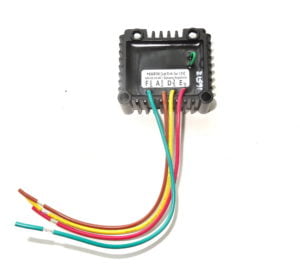The dynamo with its fully regulated output would have appeared to have been an ideal choice when compared to the early unregulated 6 volt motorcycle alternators. However if semi-conductor technology been further advanced in the 1960s alternators would have taken precedence far sooner. Back then permanent magnet alternators could only be regulated by a complex headlamp switch to connect windings when different lights were switched on or off. This and an oversized battery that would soak up surges in power and to a certain degree hold the system at 6 volts. It was crude to say the least and only worked when the battery was fully charged. Dynamos on the other hand were fully regulated and would correctly charge the battery without over charging. However dynamos don’t like heavy loads, low engine speeds, vibration, oil or dirt which if it gets on to the commutator will cause nuisance charging problems. The low resistance of the armature windings gives them a tendency to overheat as a high current can flow in them. Mechanical regulators of the time were a marvel of ingenuity, they were finely balanced by virtue of special steel springs whose characteristics compensated for temperature as the unit heated up. These gave accurate control to both the voltage and the current which ensures the armature remains at a safe temperature. Modern electronic versions must also control voltage and the current flow, before making a purchase its essential to check the unit controls armature current.
Getting It Right
Getting it Right
A well set up and maintained dynamo works perfectly well, especially if combined with modern solid state regulators and LED lights. LED headlamps consume so little power the dynamo is left with very little work to do. Once correctly overhauled even a short, 36 watt original Lucas dynamo will charge the battery and run all day with super-bright LED lights on full, and still have power to spare!
Many so called ‘dynamo problems’ are caused by age, wear, lack of servicing, shoddy overhauls or low quality parts. An important factor to consider is age of the insulated wire used in the windings as this degrades with time, even if not used. Moisture and thermal cycling take their toll will hasten this process. The vast majority of dynamos are well over fifty years old now and it is ludicrous to believe electrical insulation this old will still be reliable. Electricity is very like water in finding the easiest way to flow, it will work away at any weak point in the insulation until the ammeter is showing only a discharge.
Rex’s stock a wide range of newly manufactured dynamo parts including windings and UK made voltage regulators that control both voltage and current. LED lights were recently legalised for road use on older machines in the UK, LED headlamps use so little power that the dynamo can easily power them and have plenty left over for electronic ignition and battery charging.
Dynamos regulators must control both voltage and current. Without these features it is easy to drive the dynamo windings so they become dangerously hot. Many low cost regulators sold for dynamos prove to be alternator regulators without current control. These simply not to work with dynamos, causing charging faults, wasted time & money then inconvenience having to replace them with a regulator of the proper type and quality.
12 Volt Conversions - The Options
Solid-state – 12 volt voltage regulator.
Provided the dynamo has been recently overhauled with new windings it is simple to regulate the dynamo to 12 volts. Before re-regulation is a viable option the 6 volt dynamo must be in tip top condition. Attempting this with old, tired windings will only highlight any weakness in them. We stock a regulator that will switch between 6 and 12 volts. Clever electronics minimises the increase of revs needed before charging commences.
Positive points: This is by far the cheapest and simplest option and works extremely well in most cases. Rex’s supply a British designed and manufactured regulator with a clever feature where by cutting a loop of wire the same unit becomes 12 volt.
Negative points: Slightly higher revs are needed before charging commences, slow revving models may exhibit reduced charging rates at normal cruising speeds, especially if the final drive gearing has been set to allow lower engine RPM at cruising speeds.
Dynamo drive ratio kits
There are companies who offer very well-made kits that alter the drive ratio to the dynamo, increasing it by 10 percent or more. You have to weigh these up on a case by case basis. A slow running single cylinder side valve may well benefit from speeding up the dynamo, however a more rev happy twin could easily drive the dynamo too hard. There is a considerable cost to these kits to be considered.

Rebuilding The Dynamo With 12 Volt Windings
Positive points: Fitting windings that have been designed to supply 12 volts is by far the the best solution. The dynamo will produce the correct output without having to spin the dynamo faster.
If the dynamo is in need of an overhaul there is strong case for requesting 12 windings as there is little difference in price compared to 6 volt parts. The fully converted dynamo needs no modification to the drive train as the dynamo will give good output without the requirement to increase the armature’s drive speed.
Negative points: To return to six volts would require the windings to be replaced with six volt items.
You may be wondering what the fuss over 12 volts is about, especially as conversion does nothing to increase the power produced and 6 volts worked quite happily for all this time. However with a 12 volt system lights are noticeably brighter.
The case for using 12 volts over 6 is simple, the losses due to the natural resistance in switches and wiring are much reduced in a 12 volt system. Because of this far more of the power generated actually actually arrives at the bulbs. Additionally 6 volt batteries and bulbs have limited availability. Six volt bulbs also have not been widely available at petrol stations for many years.
DIY Overhaul
DIY Overhaul
For those who are looking to perform their own dynamo overhaul you should be mindful that the repair of automotive items is highly specialised requiring knowledge and skill along with the correct tools and technical data. We provide the Lucas manuals without charge on the technical support page of our website. We also stock a good range of Lucas dynamo parts and repair kits that are quality assured, fully checked and tested.
Advice on Batteries
AGM batteries are the evolution of traditional wet batteries and offer many advantages with few of the disadvantages. They are trouble-free on classic machines where a voltage regulator is fitted. AGM batteries are charged with normal chargers and give many years service, typically 5 years or longer. They have no liquid acid inside to spill on to your paint or chrome work and can safely be used on their side if required. Unlike wet batteries, AGM will tolerate long periods without use, generally they can be left for a year not connected to any charger and you’ll find them working perfectly (although this practise is not recommended). It’s worth investing in a modern ‘intelligent’ charger, Mottobatt recommend their own and these work best with Motobatt batteries. Leaving your battery connected to an ‘intelligent’ maintenance charger will greatly prolong its life.
A car battery charger is just too big and will damage your motorcycle battery, these must never be used. Chargers must cut out once the battery reaches full charge, even trickle chargers must cut off to avoid damaging your battery. A battery charger that gives continuous output, however small is likely to cause damage if left on too long. Intelligent chargers will cut off automatically.
AGM batteries require a good voltage regulator, whether you have a dynamo or alternator. The truth behind tales of woe are usually due to cheap regulators, or alternators where no regulator was fitted. Without a regulator in the system all manufacturers will declare the battery warranty void.
Lithium batteries must never be used, they have exacting charging requirements that old systems cannot meet. Regulators are designed for lead acid batteries, not lithium.
Amp/hour
Provided you have a good solid state voltage regulator, a 6 volt battery of 6 amp hours is more than sufficient with an alternator or dynamo with an output up to 10 amps. Larger batteries simply need more power to charge them up. For 6 volt, 60 watt dynamos a battery between 5-10 amps is all that is required; 36 watt dynamos can get away with using a 4-8 amp battery. This advice applies equally to 12 volt converted units.
Testing a dynamo’s output
This is not intended to be a full guide as tests vary depending on the exact unit. The definitive testing will be found in the bike’s shop manual. A copy is invaluable and the owner must have the manual for their machine on hand, it is every bit as vital as a set of spanners and screw drivers.
To check for output, measure the battery voltage with the engine idling, as it is revved it will rise to 7.0 to 7.2V (6 volt system) or 14.0 to 14.4V (12 volt system). A more rudimentary test is to disconnect the regulator, connect the F & D terminals on the dynamo together then connect a 12V headlamp bulb between the dynamo body and the joined F & D terminals. The bulb should be bright with the engine at idle.
We hope this has been a useful insight, a full version of this article is avaialable to download from the tech support page on our website. This also looks at flashing the dynamo and checking the brushes are connected corectly
